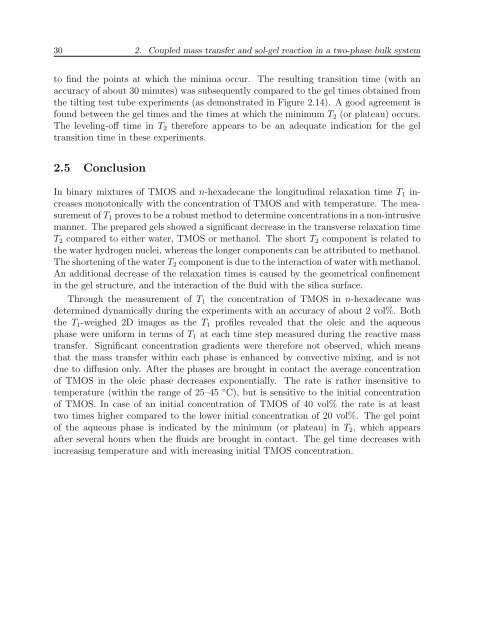Untitled - Technische Universiteit Eindhoven
Untitled - Technische Universiteit Eindhoven
Untitled - Technische Universiteit Eindhoven
- No tags were found...
You also want an ePaper? Increase the reach of your titles
YUMPU automatically turns print PDFs into web optimized ePapers that Google loves.
30 2. Coupled mass transfer and sol-gel reaction in a two-phase bulk systemto find the points at which the minima occur. The resulting transition time (with anaccuracy of about 30 minutes) was subsequently compared to the gel times obtained fromthe tilting test tube experiments (as demonstrated in Figure 2.14). A good agreement isfound between the gel times and the times at which the minimum T 2 (or plateau) occurs.The leveling-off time in T 2 therefore appears to be an adequate indication for the geltransition time in these experiments.2.5 ConclusionIn binary mixtures of TMOS and n-hexadecane the longitudinal relaxation time T 1 increasesmonotonically with the concentration of TMOS and with temperature. The measurementof T 1 proves to be a robust method to determine concentrations in a non-intrusivemanner. The prepared gels showed a significant decrease in the transverse relaxation timeT 2 compared to either water, TMOS or methanol. The short T 2 component is related tothe water hydrogen nuclei, whereas the longer components can be attributed to methanol.The shortening of the water T 2 component is due to the interaction of water with methanol.An additional decrease of the relaxation times is caused by the geometrical confinementin the gel structure, and the interaction of the fluid with the silica surface.Through the measurement of T 1 the concentration of TMOS in n-hexadecane wasdetermined dynamically during the experiments with an accuracy of about 2 vol%. Boththe T 1 -weighed 2D images as the T 1 profiles revealed that the oleic and the aqueousphase were uniform in terms of T 1 at each time step measured during the reactive masstransfer. Significant concentration gradients were therefore not observed, which meansthat the mass transfer within each phase is enhanced by convective mixing, and is notdue to diffusion only. After the phases are brought in contact the average concentrationof TMOS in the oleic phase decreases exponentially. The rate is rather insensitive totemperature (within the range of 25–45 ◦ C), but is sensitive to the initial concentrationof TMOS. In case of an initial concentration of TMOS of 40 vol% the rate is at leasttwo times higher compared to the lower initial concentration of 20 vol%. The gel pointof the aqueous phase is indicated by the minimum (or plateau) in T 2 , which appearsafter several hours when the fluids are brought in contact. The gel time decreases withincreasing temperature and with increasing initial TMOS concentration.
















